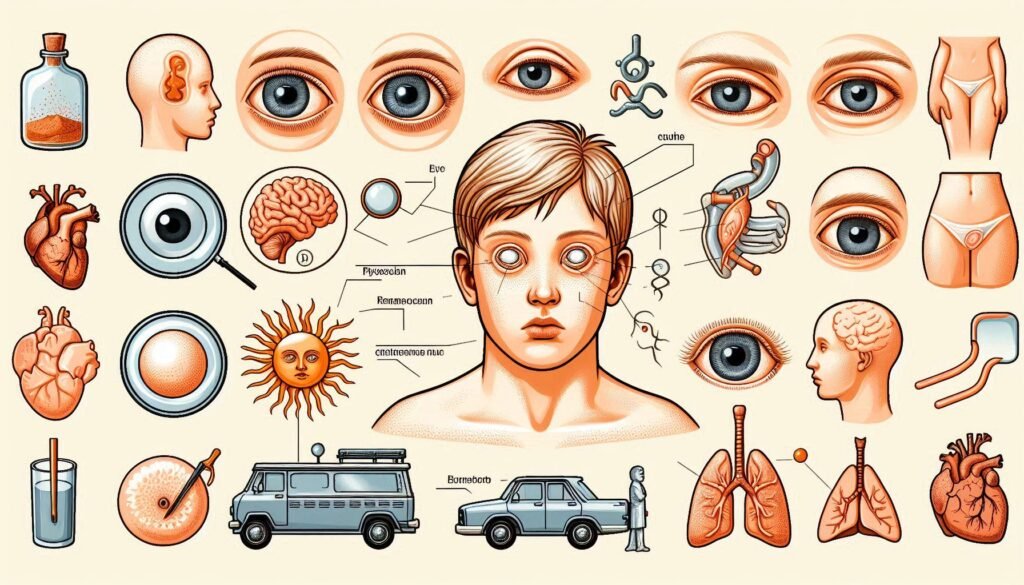Oculocutaneous Albinism Syndrome is a genetic condition that affects both the skin and eyes, leading to unique challenges for those who live with it. Characterized by a lack of melanin, this syndrome manifests in various ways, from light-sensitive skin to vision issues that can impact daily life. As awareness grows around albinism, it’s crucial to delve deeper into its complexities—understanding its genetic basis, clinical features, and management options.
This comprehensive guide aims to provide valuable insights into Oculocutaneous Albinism Syndromes while shedding light on the experiences of affected individuals and their families. Whether you’re seeking information for yourself or a loved one, you’ll find essential details here that empower you with knowledge about this often-misunderstood condition.
Understanding Oculocutaneous Albinism: An Overview
Oculocutaneous Albinism (OCA) is a genetic disorder characterized by reduced or absent melanin production. This lack of pigment affects the skin, hair, and eyes, leading to distinctive physical traits. Individuals with OCA often have very light skin and hair compared to their peers.
The condition is caused by mutations in specific genes involved in melanin biosynthesis. These changes can result in varying degrees of pigmentation loss among different types of OCA.
“What Are The Signs of Y Chromosome Infertility Syndrome?”
People with this syndrome may experience heightened sensitivity to sunlight and vision problems due to abnormal retinal development. Understanding these aspects helps foster compassion and support for those living with Oculocutaneous Albinism Syndrome.

Genetic Basis: Types of Oculocutaneous Albinism (OCA1-OCA7)
Oculocutaneous Albinism (OCA) comprises several types, each linked to specific genetic mutations. OCA1 is caused by mutations in the TYR gene, leading to a complete absence of melanin production. It has two subtypes: OCA1A, which features no pigmentation, and OCA1B with some pigment.
OCA2 arises from alterations in the OCA2 gene and typically results in reduced melanin levels but not total lack. Other types include OCA3 (TYRP1 gene mutation) and OCA4 (SLC45A2 gene mutation), both contributing to different pigmentation patterns.
“Why Does Zaitsev Syndrome Affect Development?”
Less common forms like OCA5 through 7 are also recognized due to distinct genetic contributions that affect melanin biosynthesis.
Melanin Biosynthesis and Pathophysiology of Albinism
Melanin is a pigment responsible for the color of skin, hair, and eyes. It is produced by specialized cells called melanocytes. In oculocutaneous albinism syndrome, mutations in genes involved in melanin biosynthesis disrupt this process.
The most common mutation affects the tyrosinase enzyme, which plays a crucial role in converting the amino acid tyrosine into melanin. Without adequate melanin production, individuals develop lighter skin and hair tones.
“How Does Zaspopathy Syndrome Impact Health?”
This lack of pigmentation impacts not just appearance but also health. Reduced melanin increases vulnerability to UV radiation and associated risks like skin cancer. Understanding these mechanisms provides insight into managing albinism effectively.
Clinical Features: Skin Manifestations and Pigmentation Abnormalities
Individuals with Oculocutaneous Albinism Syndrome often present with distinct skin manifestations. The most notable feature is a lack of pigmentation, which results in very light or white skin. This absence of melanin makes the skin more susceptible to sunburn and damage.
“What Causes Zellweger Syndrome? Metabolic Guide”
Pigmentation abnormalities can vary across different types of albinism. Some people may exhibit patchy pigmentation, while others experience complete depigmentation. These variations depend on the specific genetic mutations involved.
Additionally, individuals might develop freckles or moles that are lighter than those seen in typical populations. Regular monitoring by dermatologists is crucial for managing these skin features effectively and preventing complications like skin cancer.
Ocular Manifestations in Oculocutaneous Albinism
Individuals with Oculocutaneous Albinism often experience significant ocular manifestations. The most common issues include reduced visual acuity and nystagmus, a condition characterized by involuntary eye movements. These symptoms can severely impact daily activities.
“Why Does Zamzam Syndrome Affect Growth?”
Moreover, individuals may have strabismus, where the eyes do not align properly. This misalignment can lead to amblyopia or “lazy eye,” further complicating vision challenges.
The lack of melanin also affects retinal development and function. People with this condition are more susceptible to light sensitivity and may struggle in bright environments, necessitating specialized care for optimal visual health.
Diagnosis: Clinical Evaluation and Genetic Testing
Diagnosis of Oculocutaneous Albinism Syndrome begins with a thorough clinical evaluation. Healthcare professionals assess the individual’s history, family background, and specific symptoms. A detailed physical examination often reveals characteristic skin and eye features associated with albinism.
“How Does Zavanelli Syndrome Impact Childbirth?”
Genetic testing plays a crucial role in confirming the diagnosis. This involves analyzing DNA to identify mutations linked to different types of oculocutaneous albinism, such as OCA1 or OCA2. Knowing the exact type helps tailor management strategies effectively.
Early diagnosis is vital for timely interventions that improve quality of life. Accurate identification can also assist families in understanding inheritance patterns and making informed decisions about future pregnancies.
Differential Diagnosis: Other Forms of Albinism and Hypopigmentation
Differential diagnosis of oculocutaneous albinism syndrome involves distinguishing it from other forms of albinism and conditions causing hypopigmentation. For instance, ocular albinism primarily affects eye pigmentation without significant skin involvement.
Additionally, disorders like Hermansky-Pudlak syndrome combine features like albinism with bleeding issues due to platelet dysfunction. This can complicate the clinical picture.
Other relevant conditions include vitiligo, which causes localized loss of skin color but does not affect the eyes or hair in the same way as oculocutaneous albinism. Accurate diagnosis is crucial for effective management and treatment strategies tailored to each condition’s unique challenges.
Management of Dermatological Aspects
Managing the dermatological aspects of Oculocutaneous Albinism Syndrome is crucial for patient well-being. Individuals often experience skin sensitivity and an increased risk of sunburn due to a lack of melanin. Regular use of broad-spectrum sunscreen with high SPF is essential.
Additionally, protective clothing should be worn to shield against UV radiation. This includes hats and long-sleeve garments to minimize exposure during peak sunlight hours.
Routine dermatologist visits can help monitor skin health and address any emerging concerns promptly. Early intervention can prevent complications such as skin cancer, which individuals with albinism are at higher risk for developing over time.
Ophthalmological Care and Visual Rehabilitation
Ophthalmological care is crucial for individuals with Oculocutaneous Albinism Syndrome. Regular eye examinations help monitor vision changes and detect potential complications early. Eye specialists can provide tailored strategies to address visual impairments.
Visual rehabilitation plays a significant role in improving quality of life. This may involve the use of low-vision aids, which enhance remaining sight, or specialized training to develop skills for navigating different environments safely.
Support from occupational therapists can also be beneficial. They work with individuals to adapt daily activities, ensuring independence and confidence despite visual challenges. Comprehensive care promotes better outcomes for those affected by this condition.
Sun Protection Strategies and Skin Cancer Prevention
Individuals with Oculocutaneous Albinism Syndrome are at a heightened risk for skin damage due to their lack of melanin. Melanin provides essential protection against harmful UV rays, making sun safety crucial.
Effective sun protection strategies include wearing broad-spectrum sunscreen with SPF 30 or higher. It’s advisable to reapply every two hours and after swimming or sweating. Protective clothing, such as long sleeves and wide-brimmed hats, can also help shield the skin from direct sunlight.
Seeking shade during peak sunlight hours—typically between 10 AM and 4 PM—is another key strategy. Regular skin examinations can aid in early detection of any abnormal growths that may indicate skin cancer.
Genetic Counseling and Family Planning
Genetic counseling plays a crucial role for families affected by Oculocutaneous Albinism Syndrome. It helps individuals understand the genetic basis of the condition and its inheritance patterns. Counselors provide information about the likelihood of passing on albinism to future generations.
Family planning becomes essential when considering options like preimplantation genetic diagnosis (PGD) or prenatal testing. These methods can help prospective parents make informed decisions regarding their family’s health.
Support from professionals also addresses emotional concerns that may arise during this process. Families gain insights into coping mechanisms, resources, and support networks tailored to their unique experiences with albinism. This holistic approach fosters understanding and empowerment in family planning decisions.
Psychosocial Impact of Oculocutaneous Albinism
Individuals with Oculocutaneous Albinism often face unique psychosocial challenges. Social stigma and misconceptions about albinism can lead to feelings of isolation. Many experience bullying or discrimination due to their appearance, impacting self-esteem.
Family dynamics may also be affected. Parents might struggle with understanding the condition, leading to stress within the household. Support networks play a crucial role in fostering resilience among those affected.
Mental health issues are common, including anxiety and depression. Accessing support groups can provide emotional relief and connection. Building awareness in communities is essential to promote acceptance and reduce prejudice against individuals with albinism.
Educational Considerations for Visually Impaired Children
Visually impaired children with Oculocutaneous Albinism Syndrome often face unique challenges in educational settings. Tailoring learning experiences to their specific needs can foster both academic and personal growth. Incorporating assistive technologies, such as screen readers or audio books, enhances accessibility.
Teachers should be trained in adaptive strategies that accommodate different learning styles. For instance, tactile materials or oral instructions can significantly aid comprehension. Additionally, promoting an inclusive environment helps peers understand and support these children.
Collaboration among educators, parents, and specialists is crucial for developing effective Individualized Education Plans (IEPs). Regular assessments ensure the child’s evolving needs are met while encouraging independence and self-advocacy skills essential for future success.
Long-term Prognosis and Quality of Life
The long-term prognosis for individuals with Oculocutaneous Albinism Syndrome varies widely. Factors such as the type of albinism, associated ocular abnormalities, and access to care significantly influence outcomes. Many people manage to lead fulfilling lives but may face challenges.
Quality of life can be affected by physical health issues and social interactions. Increased sensitivity to sunlight often leads to skin problems, while visual impairment can hinder educational and employment opportunities.
Support from healthcare providers, educators, and family plays a crucial role in enhancing life quality. By addressing both medical needs and psychosocial factors, individuals with this syndrome can achieve better integration into society.
Emerging Therapies and Clinical Trials
Researchers are actively exploring emerging therapies for Oculocutaneous Albinism Syndrome, focusing on innovative gene-editing techniques. These methods aim to correct the underlying genetic mutations responsible for melanin deficiency. By utilizing CRISPR technology, scientists hope to restore normal pigment production in affected individuals.
Clinical trials are underway to evaluate the safety and efficacy of these targeted approaches. Participants in these studies receive close monitoring as researchers gather vital data on treatment outcomes. The potential benefits of successful trials could revolutionize management strategies.
In addition, pharmacological agents that promote melanin synthesis are also being investigated. These new treatments may offer hope beyond traditional care practices, providing options for better skin protection and visual health enhancement.
Global Perspectives: Albinism in Different Populations
Albinism manifests differently across the globe, influenced by cultural perceptions and societal structures. In some regions, particularly in sub-Saharan Africa, individuals with Oculocutaneous Albinism face significant discrimination and violence due to harmful myths about their condition. This has led to increased vulnerability and a lack of access to essential services.
Conversely, in Western countries, awareness campaigns have improved understanding and acceptance of albinism. Educational resources promote inclusivity for those affected by the syndrome.
In Asia, attitudes vary widely; while some communities embrace education on genetic conditions like albinism, others still hold onto stigmas that can hinder social integration. Access to healthcare remains inconsistent worldwide.
Advocacy and Support Organizations
Numerous advocacy and support organizations exist to assist individuals affected by Oculocutaneous Albinism Syndrome. These groups offer resources, education, and networking opportunities for families navigating this condition. They aim to raise awareness about the challenges faced by those with albinism.
Organizations like the National Organization for Albinism and Hypopigmentation (NOAH) play a crucial role in providing educational materials and hosting events. They connect individuals with similar experiences, fostering a sense of community.
Additionally, these groups advocate for rights and access to services. They work tirelessly to combat discrimination while promoting inclusivity in various spheres of life, from healthcare to education. Their efforts are vital in improving the lives of those affected by oculocutaneous albinism.
Legal and Social Issues: Combating Discrimination
Individuals with Oculocutaneous Albinism Syndrome often face discrimination in various aspects of life. This includes difficulties in employment, education, and social interactions due to misconceptions about their condition.
Stigmas surrounding albinism can lead to marginalization and isolation, particularly in communities lacking awareness. Education is crucial for fostering understanding and acceptance.
Advocacy groups play a vital role in combating these issues. They promote inclusion and push for legislative changes that protect the rights of those affected by albinism. By raising awareness and providing support resources, society can work toward eradicating discrimination against individuals with this syndrome.
Current Research in Melanin Synthesis and Gene Therapy
Current research in melanin synthesis is advancing our understanding of the biochemical pathways that contribute to pigmentation. Scientists are exploring how disruptions in these pathways lead to oculocutaneous albinism syndrome. This knowledge is crucial for developing targeted therapies.
Gene therapy offers a promising avenue for those affected by this condition. By correcting or replacing defective genes associated with melanin production, researchers aim to restore normal pigmentation and improve visual function.
Recent clinical trials are investigating various gene editing techniques, including CRISPR-Cas9 technology. These innovations could pave the way for effective treatments, enhancing both skin and eye health for individuals with oculocutaneous albinism syndrome.
Future Directions in Oculocutaneous Albinism Management
As research continues to advance, the future of managing Oculocutaneous Albinism Syndrome looks promising. Scientists are exploring innovative therapies focusing on gene editing and melanin synthesis enhancement. These breakthroughs may lead to more effective treatments that address both cosmetic concerns and associated health issues.
Clinical trials are actively investigating potential pharmacological options aimed at improving pigmentation. Such developments could greatly enhance the quality of life for individuals affected by this condition. Additionally, increased awareness and advocacy efforts can help facilitate better access to care and resources.
Collaboration among researchers, healthcare providers, and support organizations is essential for driving progress in treatment strategies. By prioritizing education about Oculocutaneous Albinism Syndrome within medical communities, we can ensure timely diagnoses and tailored management plans that cater to individual needs. The journey toward improved outcomes is ongoing, with hope for a brighter future ahead.


